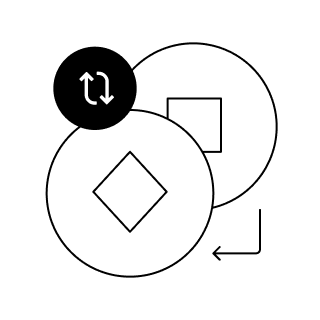What’s Optimism (OP)? How can I buy it?
What is Optimism?
Optimism is a Layer 2 (L2) scaling network built on top of Ethereum designed to make transactions faster and cheaper while inheriting Ethereum’s security guarantees. It does this by using a family of technologies known as optimistic rollups, which batch many transactions off-chain and post compressed data back to Ethereum (Layer 1, or L1). By moving most computation off L1, Optimism significantly reduces gas costs and increases throughput for users and developers of decentralized applications (dApps).
The Optimism ecosystem includes:
- The OP Mainnet (formerly “Optimism Mainnet”): the flagship L2 network where users transact.
- The OP Stack: a modular, open-source software framework for building L2 (and L3) chains with shared standards and interoperability.
- The Optimism Collective: a community-driven governance system composed of token holders and non-token contributors, aimed at funding public goods and stewarding the protocol’s evolution.
- The OP token: used for governance in the Optimism Collective and to support the ecosystem’s growth through grants and incentive programs.
Optimism is part of a broader “Superchain” vision—an interconnected network of chains built on the OP Stack that share security, communication standards, and, increasingly, liquidity and tooling.
How does Optimism work? The tech that powers it
At a high level, Optimism uses optimistic rollups to scale Ethereum with the following core components:
-
Transaction batching and data availability
- Users submit transactions to the Optimism sequencer.
- The sequencer orders transactions, executes them off-chain, and periodically posts compressed transaction data (calldata) to Ethereum. This ensures data availability on L1—anyone can reconstruct the L2 state from L1 data.
-
Optimistic execution model with fraud proofs
- “Optimistic” means Optimism assumes transactions are valid by default. To keep participants honest, the system allows anyone to challenge incorrect state transitions within a dispute window using fraud proofs.
- If a fraud proof succeeds, the invalid state is rolled back and the malicious actor is penalized. This mechanism gives Optimism “Ethereum-grade” security while retaining high throughput.
-
Bridging between L1 and L2
- Assets and messages can be bridged trustlessly using smart contracts on L1 and L2. Deposits from L1 to L2 are fast; withdrawals from L2 to L1 typically have a challenge period (e.g., ~7 days) to allow fraud challenges.
- Third-party bridge providers can offer faster exits by taking on interim liquidity risk.
-
The sequencer and proposer roles
- The sequencer provides rapid transaction inclusion and UX (near-instant confirmations) but does not have finality control—final settlement occurs on Ethereum when batches are posted.
- Proposers post state roots and batch data to L1. Over time, Optimism’s roadmap includes decentralizing sequencing and proposing, reducing reliance on any single operator.
-
The OP Stack architecture
- Modular design: separates consensus/ordering, execution, settlement, and data availability layers. This lets different OP Stack chains customize components such as execution clients, DA layers, and proving systems.
- Ethereum equivalence: Optimism aims for high compatibility with Ethereum tooling (Geth-derived execution client), minimizing differences so dApps can deploy with minimal changes.
- Interoperability: OP Stack chains are designed to interoperate, enabling shared governance and cross-chain messaging in the emerging Superchain.
-
Fault proofs and upgrades
- Optimism has been rolling out a next-gen fault-proof system intended to be more robust and permissionless. This includes multi-proof architectures, improved dispute games, and step-by-step on-chain verification to minimize trust assumptions.
- Protocol upgrades are coordinated through governance with a strong emphasis on security audits, testnets, and measured rollouts.
-
Security model and finality
- Economic security relies on Ethereum for data availability and settlement, with fraud proofs enforcing correctness.
- Users should distinguish between:
- Instant UX confirmations from the sequencer (soft confirmations),
- L2 finality after batches post to L1,
- L1 finality after Ethereum finalizes the relevant blocks (dependent on Ethereum’s consensus finality).
What makes Optimism unique?
-
The Superchain vision and OP Stack standardization
- Optimism’s OP Stack has been adopted by multiple high-profile ecosystems to launch their own L2s and app-specific chains (e.g., Base by Coinbase, World Chain by Worldcoin, and others). This creates network effects across tooling, developer experience, and liquidity.
- A shared standard encourages seamless cross-chain messaging, common upgrades, and unified security practices across OP Stack chains.
-
Strong alignment with public goods funding
- Through the Optimism Collective and Retroactive Public Goods Funding (RPGF), Optimism directs a share of revenues and token allocations to projects that create public value (e.g., open-source infrastructure, education, research). This governance philosophy is distinctive among L2s.
-
Ethereum equivalence for developers
- By staying close to Ethereum’s architecture (EVM-equivalence and reuse of core clients), Optimism minimizes friction for developers migrating from L1 or other EVM chains, reducing maintenance overhead and unexpected edge cases.
-
Active roadmap toward decentralization
- Optimism has articulated and executed on a path to decentralize sequencing, enhance fault proofs, and improve censorship resistance. The emphasis on formal verification, multi-client support, and permissionless proving distinguishes its security roadmap.
-
Ecosystem traction and partnerships
- With major partners building on the OP Stack and a growing catalog of dApps (DeFi, gaming, identity, social), Optimism benefits from shared liquidity and brand credibility, reinforcing its competitive position in the L2 landscape.
Optimism price history and value: A comprehensive overview
Note: The OP token is primarily a governance and ecosystem token, not a claim on protocol fees or equity. Market prices are volatile and driven by supply schedules, ecosystem growth, broader crypto conditions, and governance expectations. Always verify current figures from reputable data providers.
-
Launch and distribution
- OP launched in 2022 with an airdrop to early users and contributors. Subsequent airdrops and incentive programs have broadened token distribution.
- The token’s supply schedule includes allocations for ecosystem funding, the Foundation, investors, and contributors, with planned unlocks over time. Token unlocks can affect circulating supply and price dynamics; consult official announcements and tokenomics dashboards for the latest schedules.
-
Market performance drivers
- L2 adoption metrics: daily active addresses, transactions per second (TPS), total value locked (TVL), and dApp growth on OP Mainnet and OP Stack chains.
- Competitive landscape: relative progress vs. other L2s (e.g., Arbitrum, Base, zkSync, Starknet), especially around decentralization, fees, and developer traction.
- Governance milestones: upgrades to fault proofs, sequencer decentralization, Superchain interoperability, and RPGF cycles can influence sentiment.
- Macro crypto cycles: Bitcoin and Ethereum market phases, regulatory developments, and risk appetite affect all altcoins, including OP.
-
Historical volatility
- Like most governance tokens, OP has experienced significant price swings tied to unlocks, incentive announcements, and market-wide rallies or drawdowns.
- Use historical charts and on-chain metrics from sources like CoinGecko, CoinMarketCap, The Block, Messari, or DefiLlama to contextualize performance across cycles.
Because prices and supply figures change frequently, rely on up-to-date dashboards (e.g., Optimism’s official docs and analytics, L2Beat for security and metrics, DefiLlama for TVL) rather than static summaries.
Is now a good time to invest in Optimism?
This is not financial advice. Whether OP is a suitable investment depends on your risk tolerance, time horizon, and thesis about L2 scalability and the Superchain. Consider the following due diligence points:
-
Thesis alignment
- Do you believe L2s will capture a large share of Ethereum activity? If yes, do you think OP Stack standardization and Superchain interoperability will attract sustained developer and user adoption?
-
Technology and roadmap risk
- Track progress on fault proofs, sequencer decentralization, censorship resistance, and cross-chain interoperability. Delivery against these milestones reduces technical and governance risk.
-
Token utility and governance
- OP is primarily a governance token. Evaluate the value accrual mechanisms: Are there credible paths for protocol revenues or sequencer profits to support ecosystem funding that benefits token holders indirectly via governance influence? Read Optimism Collective proposals and results.
-
Competitive positioning
- Compare fees, performance, security features, and ecosystem traction versus other L2s. Watch adoption of the OP Stack by third parties and the health of marquee apps and partners.
-
Supply dynamics and unlocks
- Review circulating supply, vesting schedules, and planned distributions. Large unlocks or incentive programs can create short-term selling pressure.
-
On-chain and market metrics to monitor
- Daily transactions and active addresses on OP Mainnet and other OP Stack chains.
- TVL growth and diversity of protocols (DeFi, gaming, social).
- Bridge flows (net inflows/outflows).
- Developer activity (GitHub commits, new deployments).
- Governance participation and RPGF outcomes.
Risk management tips:
- Size positions conservatively given volatility.
- Consider dollar-cost averaging rather than timing a single entry.
- Use reputable exchanges or self-custody with audited bridges and wallets.
- Stay informed via official Optimism channels, L2Beat, and leading analytics sites.
Key reputable resources for ongoing research:
- Optimism documentation and blog: community.optimism.io, optimism.io
- L2Beat (security, TVL, upgrade status): l2beat.com
- Analytics and market data: DefiLlama, CoinGecko, CoinMarketCap, The Block, Messari
- Governance: gov.optimism.io and the Optimism Collective updates
If your goal is to use Ethereum dApps with lower fees and faster confirmations while retaining L1 security, Optimism offers a mature, developer-friendly environment with a strong vision for interoperable L2s. As an investment, OP’s prospects hinge on the Superchain thesis, execution on decentralization and security, and sustained ecosystem adoption.
Discover the different ways to buy crypto in Singapore
Create an OKX account
Get verified
Start a trade
Enter an amount
Choose your payment method
Confirm your order
All done
Create an OKX account
Get verified
Start a trade
If Optimism isn’t available in the dropdown, purchase any of the available tokens and convert it to OP.
Place a buy order
Complete your purchase
Receive your OP
All done
Get the OKX app or Wallet extension
Set up your wallet
Fund your wallet
Find your next purchase
Note:
Tokens with the same symbol can exist on multiple networks or may be forged. Always double-check the contract address and blockchain to avoid interacting with the wrong tokens.
Trade your crypto on OKX DEX
Choose the token you’re paying with (e.g., USDT, ETH, or BNB), enter your desired trading amount, and adjust slippage if needed. Then, confirm and authorize the transaction in your OKX Wallet.
Limit order (optional):
If you’d prefer to set a specific price for your crypto, you can place a limit order in Swap mode.
Enter the limit price and trading amount, then place your order.
Receive your crypto
All done

Make informed decisions


How to get Optimism for free
See what you can do with your crypto
How to buy Optimism (OP) FAQ
Disclaimer
You are viewing content that has been summarized by AI. Please be aware that the information provided may not be accurate, complete, or up-to-date. This information is not (i) investment advice or an investment recommendation, (ii) an offer, solicitation, or inducement to buy, sell or hold digital assets, or (iii) financial, accounting, legal or tax advice. Digital assets are subject to market volatility, involve a high degree of risk, and can lose value. You should carefully consider whether trading or holding digital assets is suitable for you in light of your financial condition and risk tolerance. Please consult your legal/tax/investment professional for questions about your specific circumstances.














